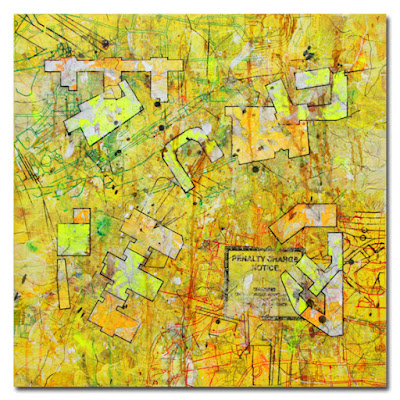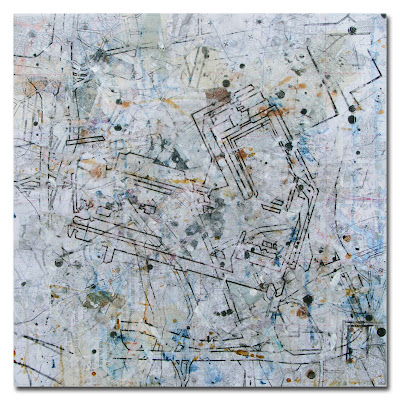 |
(L.): Francisca Aninat, 'Interior/Exterior Field', Canvas, Cardboard, Newspaper & Thread, 2007
(R.): Mona Hartoum, 'Hot Spot', Stainless Steel & Neon, 2006
(All Images: 'We Grown-Ups Can Also Be Afraid', Attenborough Arts Centre, Leicester, July 2025) |
I managed to catch up with my friend Andrew Smith, a few days ago, and we took the time to visit the 'We Grown-Ups Can also Be Afraid' exhibition at Leicester's Attenborough Arts Centre. It proved well worth the effort. Although modest in scale, the show features a well curated selection of stimulating contemporary work from the private collection of David and Indré Roberts. I won't claim any prior knowledge of them, or of the Roberts Institute of Art, but a modicum of research suggests the latter is a non-profit organisation with considerable outreach and heft. The Attenborough exhibition itself aims to showcase work that engages with a range of the crises and insecurities that haunt our world, without descending to the level of mere sloganeering or shallow didacticism - something which sometimes feels like a limiting factor in so much of the current work littering contemporary galleries across the globe.
Don't get me wrong, I have no objection to the arts being engaged with socio-political issues. Indeed, I'd even argue that it is a duty of any creative endeavour to acknowledge and critique the times in which it emerges, if it is to claim any relevance beyond being 'mere' decor/escapism. Ultimately though, I suppose I do have a basic requirement for a bit of 'Art' to remain in there too. If I want simplistic solutions, ideologically-driven polemic, or direct calls to action, I'll read a book, attend a protest rally (or some other variety of intervention), watch a documentary, sign a petition, or even sully myself with social media. The aesthetic of the protest placard or campaigning graffiti feels far more vivid on the street than in the art gallery.
 |
| Mona Hartoum, 'Hot Spot' (Detail) With Gallery View |
 |
| Nina Beier & Marie Lund, 'We Grown-Ups Can Also Be Afraid', Video, 2007 |
 |
| See Above |
There, a slower burn or more reflective approach may often have a greater effect, I would argue. Without engaging with any debates over privately accumulated collections, or the nature of the art object as status symbol/luxury indulgence, I prefer to believe that there is still an, admittedly modest, arena in which made/visual artefacts can engage us through aesthetic stimulation - first, philosophic reflection - second, and perhaps morally - third.
Direct action, the taking of sides, the pursuit of conflicts (be they ideological or military) - these activities all tend to work within traditional, entrenched thought patterns. One side pretends to 'win' while the other stores up grievance. We pick a side and embrace the associated echo chamber of opinion, or else - turn off the news and feel grateful that stuff doesn't (usually) happen here. We go round and round the mulberry bush as cities are bombed, populations are displaced, children starve, chemical plants explode and eco-systems go up in flames. (Your turn today - our turn tomorrow). Alternatively, might it be that through observation, calm reflection, engagement with the absurdity/tragic poetry of catastrophe, or even just through creative endeavour as a gesture of positivity in itself, that more flexible or adaptive solutions might one day emerge? Clearly, no single artwork could ever have prevented Auschwitz, Hiroshima, Chernobyl, Gaza, etc. but could it perhaps eventually stimulate enough critical thinking to persuade us it really wasn't a great idea last time - and still won't be the next time some idiots try it? If I'm simply deluding myself here, at least, in a show like this, I get to distract myself or virtue-signal with something a little more stimulating than a lot of what gets dished-up these days.
 |
| Francesca Aninat, 'Interior/Exterior Field' (Detail) |
 |
Fiona Banner, 'Mirror Fin, Jaguar', Polished Aircraft Tail Fin, 2006
|
Anyway, enough with the ill-thought-out philosophising. I had originally planned to discuss, in some depth, the individual pieces from the exhibition that impressed me most. But the reality is that nearly everything affected me to some degree or another. Besides that, the musings above have already taken up both time and space. Here's a rather more superficial précis, instead:
 |
| Phyllida Barlow, 'Untitled: Disaster 5', Mixed Sculptural Media & Castors, 2010 |
Mona Hartoum's, 'Hot Spot' presides over the entire gallery, bathing everything else in its infernal glow and implied heat. It functions as one of those objects that combine elegant simplicity with lasting resonance. Whilst initially intended as a geo-political commentary, it now feels equally well adapted as a symbol of the environmental conflagration now enfolding us us all. It almost feels like it's accumulating disasters as it sits there and gently buzzes to itself. Nearby, Francisca Aninat allows the accumulated detritus of her cultural origins to accrete in a new corner/location, even as it may have previously felt washed-away through displacement or migration on a similarly global scale.
Nina Beier and Marie Lund lend the show its title with their video that combines a visual meditation on the mundane environs of a Danish primary school, and a soundtrack in which unseen children rehearse a song listing the potential catastrophic fears waiting to haunt their adult lives. There's something darkly enjoyable about the way the class degenerates into infantile chaos and petty squabbling, even as their teacher struggles to focus them on the nightmares ahead. Meanwhile, Jacco Olivier's video, 'Saeftinghe' approaches things in a different but equally intriguing manner by digitally manipulating his crudely-painted evocations of disaster, conflict and ultimate submersion, as they are visited upon a tract of Dutch landscape. In passing, it impresses me that both videos manage to pack a considerable punch whilst being pretty short in duration by normal art-video standards.
 |
| Jacco Olivier, 'Saeftinghe', Video, 2006 |
 |
| See Above |
Fiona Banner provokes literal reflection by mirror-polishing the tail fin of a war plane ('Mirror Fin, Jaguar'), questioning the double-think that allows us to find such sleek beauty in the contours of a sophisticated killing machine. It's another of those simultaneously elegant and profound statements that seems to encapsulate something of humanity's gleeful death-drive. Phyllida Barlow doesn't summon quite the same seductive beauty for her semi-abstract blob of mangled detritus, 'Untitled: Disaster 5', but it appeals to me, nonetheless. In execution, it might be little more than the kind of 'experimental' foamed-together crap pile one might once have found littering the studio floors of numerous art colleges, were it not for the simple, delightful expedient of attaching castors to its underside. A small portion of portable disaster - suddenly, that almost feels like the kind of thing Duchamp himself might have dreamt-up.
 |
| Doris Salcedo, 'Atrabiliaros', Shoes, Cow Bladder & Surgical Thread, 1996 |
More solemn are the shoes of the Latin American disappeared that Doris Salcedo obscures behind stitched viceral membranes, in her small 'Atrabiliaros' instillation. The context is different, but I find it impossible not to see echoes of the Nazi's 'final solution' here too, and ultimately, perhaps it all just boils down to a repudiation of humanity and the futile deletion of individuals in the end. Even more minimal and fleeting in their visual effects are Ayan Farah's stretched blanket pieces. Although resembling highly distilled abstract paintings, they are actually composed of chemical stains or collected dust, seemingly encapsulating as much time as they do materiality. By applying the residual traces of some implied cataclysm or unwanted transformation, to what should be the fabric of domestic comfort, Farah implies the ultimate fragility of whatever stable life we might attempt to construct. I'm reminded to some extent of the domestic linen that often litters the bombed-out apartments of Gaza, Syria, Kiev, wherever... but also of the grubby bedding of Leicester's own rough sleepers, or the lines of washing in the steel town of Consett, that I once observed from a train window, collecting choking brown dust, even as it dried.
 |
| Ayan Farah, Blanket Pieces, 2011 |
 |
| Ayan Farah, 'Nuuk', Sun-Bleached Copper & Dye on Stretched Blanket, 2011 |
 |
| Ayan Farah, 'Eldfell', Volcanic Ash & Dye on Stretched Blanket, 2011 |
In passing, I'll just mention that all the images here were collected with my smashing new mirrorless camera (its a Canon, for those that care). Such toys don't exactly come cheap and I suppose it might seem like a profligate indulgence, were it not for the fact that I've always regarded a 'grown-up' camera as one of life's essentials. The old DSLR responsible for nearly every image on this blog to date, has effectively reached the end of its working life (bits are literally dropping off), and goes into retirement after perhaps a million depressions of its shutter. Here's hoping this new one lasts as well in the coming years. The fact that the dense text below is legible, from what was boiled-down to a pretty small JPEG file, suggests there's nothing too shabby about it so far. I just need to decipher all those menus now...
'We Grown-Ups Can Also Be Afraid' continues until 19 October at: Attenborough Arts Centre, University of Leicester, Lancaster Road, Leicester, LE1 7HA
Written without A.I. [For better or worse]




















































